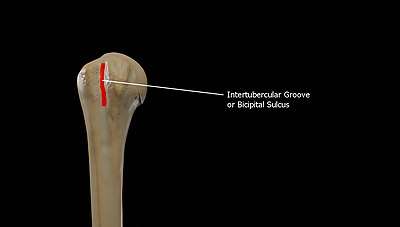Bicipital groove
The bicipital groove (intertubercular groove, sulcus intertubercularis) is a deep groove on the humerus that separates the greater tubercle from the lesser tubercle. The bicipital groove lodges the long tendon of the biceps brachii between the tendon of the pectoralis major on the lateral lip and the tendon of the teres major on the medial lip. It also transmits a branch of the anterior humeral circumflex artery to the shoulder joint.

| Bicipital groove | |
|---|---|
 Left humerus. Anterior view. (Intertubercular groove visible at top.) | |
 intertubercular groove, upper left. | |
| Details | |
| Identifiers | |
| Latin | Sulcus intertubercularis |
| TA | A02.4.04.007 |
| FMA | 23396 |
| Anatomical terms of bone | |
The insertion of the latissimus dorsi is found along the floor of the bicipital groove. The teres major inserts on the medial lip of the groove.
It runs obliquely downward, and ends near the junction of the upper with the middle third of the bone. It is the lateral wall of the axilla.[1]
Gallery

See also
- Radial groove
- Medial bicipital groove
References
This article incorporates text in the public domain from page 209 of the 20th edition of Gray's Anatomy (1918)
- "Dissector Answers - Axilla and Arm". Archived from the original on 2007-12-10. Retrieved 2007-12-23.